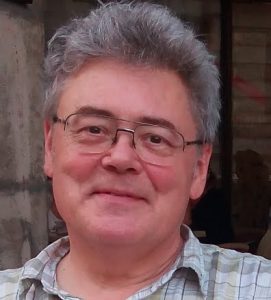András Kornai
He graduated from the Faculty of Natural Sciences of ELTE University, Faculty of Mathematics, with a specialization in algebra and number theory; his supervisor was Miklós Ajtai. He was already interested in mathematical linguistics during his university years; his diploma thesis, which was accepted in an expanded form as a university minor doctoral dissertation in 1983, was written on such a topic.
His first job was at the Hungarian Academy of Sciences' Computer Science and Automation Research Institute (SZTAKI). From 1983 to 1986, he was a postgraduate student at the Institute of Linguistics of the Hungarian Academy of Sciences, supervised by Ferenc Kiefer.
He moved to the Institute of Linguistics as a full-time employee in 1986. In 1987, he created a so-called two-level phonology and morphology-based analysis and generation program in the department of Lauri Karttunen at the Xerox Palo Alto Research Center. The thesis submitted for the defense of his candidate's dissertation already included this; he received the degree in 1989. From 1986 to 1991, he participated in postgraduate (PhD) linguistics training with a scholarship from Stanford University, where his supervisor was Paul Kiparsky. He received his MTA doctorate in 2001.
In 2007, he qualified as an applied mathematician at the Budapest University of Technology and Economics (BME), where he has been an honorary professor since 2003, a senior associate since 2006, and a professor since 2014 at the Department of Algebra. Since 2009, he has been a scientific advisor to the Hungarian Academy of Sciences (SZTAKI) and the head of the language technology group. He has published four monographs, the latest being Semantics (TypoTex 2018 and Springer Verlag, 2019); he has (co-)edited seven volumes and has published more than 100 articles in international journals and conference proceedings.
In addition to the Bolyai János Mathematical Society (BJMT) and the NJSZT, he is a member of the American Association for Computational Linguists (ACL), the Association for Computer Science (ACM), and a senior member of the Institute of Electrical Engineers (IEEE). He regularly reviews domestic and international scientific journals, as well as the National Science Foundation (OTKA) and the US National Science Foundation (NSF). He is a regularly invited speaker and has been and is participating in the organizing committees of several conferences. He was a member of the editorial board of the journal Formal Grammars, which focuses on the relationship between natural language and formal grammars, and a scientific consultant at YourAmigo Plc. (Adelaide, Australia). Between 2011 and 2013, he was the president of the ACL Association for Mathematics of Language (SIGMOL), and since 2010, he has been a member of the international advisory board of the ACL Special Interest Group on Finite-State Methods (SIGFSM). He was named a Distinguished Scientist by the ACM in 2009.
He participated in the design and development of several systems used in practice: postal and banking handwriting recognition systems, TextMonitor for extracting structured information from English text, WebCoder for analyzing medical texts, the Vizsla classification system, and the Metacarta GeoTagger, which links the virtual world to physical coordinates.
Part of his public life activity is the development of free and open source software (FOSS) technology around the world wide web. He has maintained his own internet domain for 30 years (first calera.com, then kornai.com). From the beginning, he has actively supported the development of Hungarian internet culture, including public benefit systems such as the Hun* language technology toolchain.
- Married, father of three children (2019 announcement).
Created: 2019.06.05. 12:48
Last modified: 2024.03.08. 15:18

